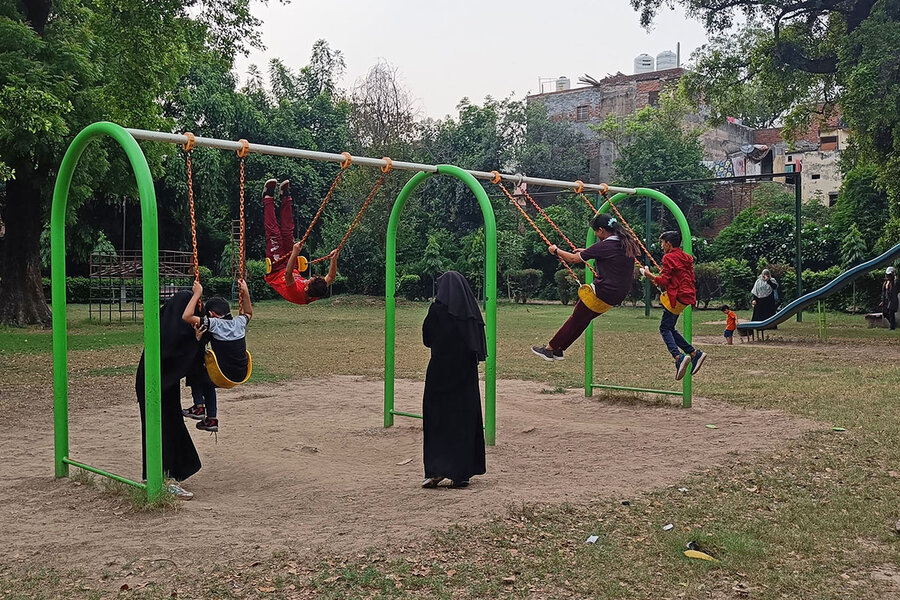‘Pink parks’: Delhi’s bid to build safer city for women sparks debate
Loading...
| Delhi
A recent evening in Purdah Bagh, an Old Delhi park reserved for women and children, offered scenes of refuge in what’s considered the most dangerous city for women in India.
Aksa Arif, who’d stopped visiting her neighborhood park to avoid lewd comments from men, took turns riding the swing with her cousins. Saba Khan watched her daughter play from her perch on an open-air exercise machine. “I can even sit here without my burqa,” she says. “I feel safe.”
Why We Wrote This
A story focused onDelhi plans to build hundreds of “pink parks” to improve women’s access to outdoor spaces. While parkgoers welcome the oasis, experts say this sort of short-term safety fix fails to move the ball forward on equality.
Parks like this are about to become more common in India’s capital. Delhi is planning to build around 250 women-only parks across the city, equipped with surveillance cameras, children’s play areas, and restrooms. Female security guards will only allow women and children under 10 to enter. Officials hope the initiative can improve women’s access to public spaces in a city where obscene remarks, pointed stares, and groping are common. But urban planning experts see the “pink parks” as a simplistic solution to complex problems of safety and equality.
“Separate does not mean equal,” says Amita Sinha, a retired professor of landscape architecture. “This kind of fragmenting of the public space along gender lines means nobody is a winner.”
Aksa Arif used to start each day with a stroll through her neighborhood park in Delhi, often accompanied by her cousin. But after a while, Ms. Arif stopped going to the park to avoid unwanted attention and lewd comments from young men.
A couple of months ago, she found a new haven: Purdah Bagh.
Dressed in a black abaya and teal sports shoes, she and her young cousins take turns riding the swing in the historic Old Delhi park reserved for women and kids. Built during the Mughal era, the park used to be frequented by elite Muslim women who observed the purdah tradition – being behind the veil at all times. Redeveloped as a women-only park in recent years, the lush green space is now a refuge where women of all religious backgrounds say they can be carefree.
Why We Wrote This
A story focused onDelhi plans to build hundreds of “pink parks” to improve women’s access to outdoor spaces. While parkgoers welcome the oasis, experts say this sort of short-term safety fix fails to move the ball forward on equality.
“I can even sit here without my burqa,” says Saba Khan, perched on an open-air exercise machine as her daughter plays nearby. “I feel safe here because there are no men.”
Parks like this are about to become more common in India’s capital. Delhi’s government is planning to build around 250 women-only parks across the city. Nicknamed “pink parks,” they will have gym equipment, surveillance cameras, children’s play areas, and restrooms. Female security guards will mind the entrance, only allowing women and children under 10 years old to enter. Officials hope the initiative can improve women’s access to public spaces in a city where obscene remarks, pointed stares, and groping are common occurrences.
But urban planning experts are ambivalent and see the parks as a simplistic solution to complex problems of safety and equality.
“Some spaces for women only would be welcome, but in the long run, we need to make all public spaces safe for women,” says Kalpana Viswanath, co-founder of a crowdsourcing app that maps unsafe areas in cities.
A double-edged sword
On a recent evening in Purdah Bagh, Reshma Parveen removed her slippers and settled onto a picnic blanket while her nieces ran off to play. “If I have to go to any other park, I have to ask my husband or brother to come with me,” she says, as late-day sun filters in through the trees and birds sing over the clamor of the street outside.
In 2012, a brutal gang rape of a young woman on a moving bus in Delhi sent shock waves across the world and made the city notorious for being unsafe for women. Nearly a third of all crimes against women in metropolitan cities in India take place in Delhi, according to data from India’s National Crime Records Bureau. Resident Madhu Goyal says she never takes a cab by herself. She’s even stopped going to India Gate, a popular landmark in central Delhi, to avoid street harassment. Inside regular parks, she has encountered men who are drunk or taking drugs. “We need more women-only parks so that we too can enjoy” the outdoors, Mrs. Goyal says.
Gender-segregated spaces aren’t new for Delhiites. The first coach of the Delhi metro is reserved for women, and regular commuter Shyamala Kumar says she prefers riding there, even outside of rush hours. A few years ago, Delhi also got its first women-only liquor store.
But more segregation can leave women with little confidence to negotiate public spaces on their own, says Amita Sinha, a retired professor of landscape architecture at the University of Illinois Urbana-Champaign.
“Separate does not mean equal,” she says. “This kind of fragmenting of the public space along gender lines means nobody is a winner.”
It also excludes other vulnerable groups, such as transgender people, notes Syeda Jenifa Zahan, an urban studies researcher at the Polytechnic University of Turin, in Italy.
“Violence against women is used as a sort of logic to create much more exclusion,” says Dr. Zahan, “and then the actual reason, which is this neoliberal patriarchal system that needs to be dismantled, that doesn’t get done.”
Instead of addressing the root cause of the problem, protectionist measures are imposed on women, she explains. They are told not to go out at night or to not wear short clothes for their own safety. It’s why most Indian hostels have nighttime curfews for girls, but not for boys.
Dr. Zahan says it’s possible that in the future if a woman is assaulted at a regular park, she may be blamed for being in a mixed-gender space, instead of going to the park designated for women, thus reinforcing victim-blaming culture.
“There’s an unspoken assumption that a loitering woman is up to no good,” write the authors of the book Why Loiter? Women and Risk on Mumbai Streets. “What women need in order to maximize their access to public space as citizens is not greater surveillance or protectionism (however well-meaning) but the right to take risks.”
Yet despite its pitfalls, Dr. Viswanath says the government’s proposal for pink parks is sparking a conversation about who gets to enjoy public spaces, which in India, are overwhelmingly male-dominated.
Designing gender-inclusive spaces
In her research, Dr. Viswanath has found that there is one thing that makes women feel safe in public spaces more than anything else – having more women around. That can be done, she says, by ensuring that public spaces are well lit at all times and that sidewalks are not broken or dirty, and by providing space for female vendors.
Some of this work is already being done: In 2019, Delhi made public bus rides free for women, and female ridership has grown since.
Another urban design concept for building women-friendly spaces is called “eyes on the street.”
“That is basically [asking], ‘When I stand on the street, can I be seen?’” explains Dr. Viswanath. When she first started doing safety audits in Delhi in the early 2000s, she says the city’s bus stops looked different. The area behind the bus stop was dark, and people’s view was obstructed by a metal structure that extended down from the roof of the shelter. Today, that structure doesn’t reach all the way to the ground, Dr. Viswanath explains, so anyone can see what’s happening behind the shelter.
Good last-mile connectivity is also important to help women feel safer traversing Delhi’s streets, says Dr. Viswanath.
But while urban design can help facilitate social change, it cannot by itself spark it, says Professor Sinha. That, she says, requires a concerted community effort and political will.









